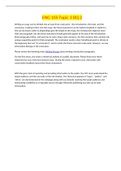Eng 105 topic 3 dq 2 Study guides, Class notes & Summaries
Looking for the best study guides, study notes and summaries about Eng 105 topic 3 dq 2? On this page you'll find 50 study documents about Eng 105 topic 3 dq 2.
Page 3 out of 50 results
Sort by
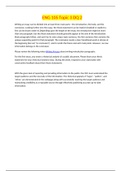
-
ENG 105 Topic 3 DQ 2
- Case • 1 pages • 2020
- Available in package deal
-
- $6.49
- + learn more
ENG 105 Topic 3 DQ 2 Writing an essay can be divided into at least three main parts—the introduction, the body, and the conclusion. Looking further into the essay, the thesis statement can be implicit (implied) or explicit (a line can be drawn under it).Depending upon the length of the essay, the introduction might be more than one paragraph, but the thesis statement should generally appear at the end of the introduction. Body paragraphs follow, and each has its own unique topic sentence, the...

-
ENG – 105 Topic 1 DQ 1 | VERIFIED SOLUTION
- Case • 1 pages • 2021
-
- $5.00
- + learn more
ENG – 105 Topic 1 DQ 1 Take a moment to reflect on past writing experiences from your academic, personal, or professional life. Answer the following questions as your initial post. Plan to have 150-200 words. 1. What was writing like for you as a child or young adult? Do you recall any vivid writing experiences? 2. How do you currently use writing in academic, personal, and professional experiences? 3. How might writing be used in future academic, personal, and professional experiences?
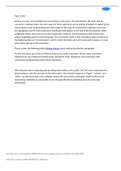
-
Case ENG 105 Topic 3 DQ 2 Topic 3 DQ 2 Writing an essay can be divided into at least three main parts—the introduction, the body, and the conclusion. Looking further into the essay, the thesis statement can be implicit (implied) or explicit (a line can be
- Case • 1 pages • 2022
-
- $11.89
- + learn more
Case ENG 105 Topic 3 DQ 2 Topic 3 DQ 2 Writing an essay can be divided into at least three main parts—the introduction, the body, and the conclusion. Looking further into the essay, the thesis statement can be implicit (implied) or explicit (a line can be drawn under it).Depending upon the length of the essay, the introduction might be more than one paragraph, but the thesis statement should generally appear at the end of the introduction. Body paragraphs follow, and each has its own unique ...

-
ENG 105 Topic 2 DQ 2
- Case • 2 pages • 2022
-
- $7.49
- + learn more
ENG 105 Topic 2 DQ 2 Review the CDC website and answer at least three of the questions below: 1. Who is the writer? 2. What is the writer’s purpose? 3. Who is the intended audience? 4. What is the broader cultural context that motivated the writing of the article? 5. How does the writer establish ethos? 6. Does the writer appeal to logos (logic)? 7. Does the writer appeal to pathos (emotions)? 8. Do you feel that the website is effective? Why or why not? Use these questions to gui...
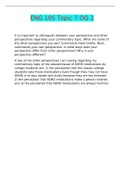
-
ENG 105 Topic 7 DQ 2
- Case • 2 pages • 2022
-
- $7.49
- + learn more
ENG 105 Topic 7 DQ 2 It is important to distinguish between your perspective and other perspectives regarding your commentary topic. What are some of the other perspectives you see? Summarize them briefly. Next, summarize your own perspective. In what ways does your perspective differ from other perspectives? Why is your perspective different? A few of the other perspectives I am seeing regarding my commentary topic of the abuse/misuse of ADHD medications by college students are; 1) the perc...
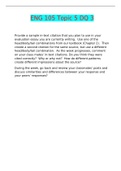
-
ENG 105 Topic 5 DQ 3
- Case • 2 pages • 2022
-
- $7.49
- + learn more
ENG 105 Topic 5 DQ 3 Provide a sample in-text citation that you plan to use in your evaluation essay you are currently writing. Use one of the head/body/tail combinations from our textbook (Chapter 2). Then create a second citation for the same source, but use a different head/body/tail combination. As the week progresses, comment on your class mates' in-text citations. Do you think they were cited correctly? Why or why not? How do different patterns create different impressions about t...

-
ENG – 105 Topic 1 DQ 2
- Case • 3 pages • 2022
-
- $7.49
- + learn more
ENG – 105 Topic 1 DQ 2 Read the Centers for Disease Control and Prevention’s page on ADHD; the link is provided below. Use the close reading techniques described in Chapter 1 of the e-book. It may be helpful to print off the page and annotate the text. Then, summarize the website in 150-250 words. Your summary should be similar to the example provided in Chapter 1 of the textbook. Your summary should answer at least three of the questions below: 1. What key facts or details does the CD...
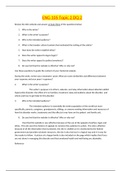
-
ENG 105 Topic 2 DQ 2
- Case • 2 pages • 2020
- Available in package deal
-
- $6.99
- + learn more
ENG 105 Topic 2 DQ 2 Review the CDC website and answer at least three of the questions below: 1. Who is the writer? 2. What is the writer’s purpose? 3. Who is the intended audience? 4. What is the broader cultural context that motivated the writing of the article? ...... document continues
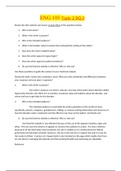
-
ENG 105 Topic 2 DQ 2
- Case • 2 pages • 2020
-
- $11.49
- + learn more
ENG 105 Topic 2 DQ 2 Review the CDC website and answer at least three of the questions below: 1. Who is the writer? 2. What is the writer’s purpose? 3. Who is the intended audience? 4. What is the broader cultural context that motivated the writing of the article? 5. How does the writer establish ethos? 6. Does the writer appeal to logos (logic)? 7. Does the writer appeal to pathos (emotions)?

Do you wonder why so many students wear nice clothes, have money to spare and enjoy tons of free time? Well, they sell on Stuvia! Imagine your study notes being downloaded a dozen times for $15 each. Every. Single. Day. Discover all about earning on Stuvia

